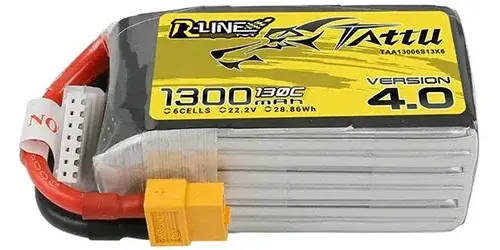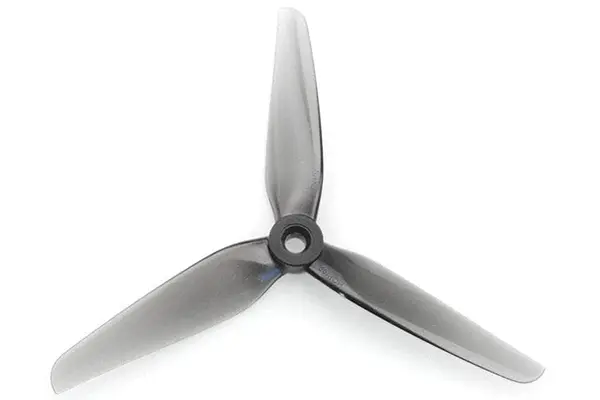Basically, all of the links on this page are affiliate links. I receive a commission (at no extra cost to you) if you make a purchase after clicking one of the affiliate links below. Read our Affiliate Link Policy for more information.
The parts on this list were selected in large part by referring to the annual MultiGP pilot survey. The Survey is the work of Shawn Ames, MultiGP Chief Operating Officer. It catalogs the equipment used by pilots entering the MultiGP Nationals each year. Additional insight was provided by Ivan Effimov (Limon). Ivan is a Betaflight developer, talented and passionate drone racer, and entertaining and educational YouTube Creator.
You should know that most FPV drone racers don’t buy BnF or RTF quads; they build their own. Yes, racers have very specific requirements for their quads that can only be met by a custom build. But that’s not the real reason they skip pre-built quads. The real reason is that racers crash and break their quads so often that they’re constantly building and repairing. Since you’re going to have to rebuild the dang thing so often, you might as well just build it yourself the first time.
We still feel obligated to put some BnF and RTF options on this page. But we also feel obligated to tell you that few racers actually use them. Especially as a beginner, the most important thing is that you have something to take to the race, no matter what it is.
FIVE33
LIGHTSWITCH RTF
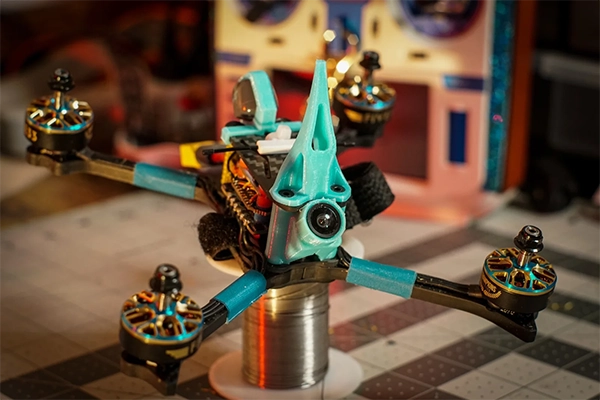
If you’re going to buy a RTF racing drone, who better to buy it from than one of the fastest, most winning-est drone racers ever: Evan Turner. His company, Five33, makes some of the most popular motors and frames used in 5” FPV racing today. This RTF build is hand-built to Evan’s personal specifications and test-flown by him before shipping. It’s essentially the same quad that Evan himself would fly at a race, built by the same team that builds his personal race drones. And yes, you’ll pay a premium for that pedigree.
This build can be ordered with either the V2 LightSwitch frame or the LightSwitch Ultra frame. The Ultra frame comes in under 50 grams. The main way it saves this weight is by using 5mm arms instead of the 6mm arms on the V2 Lightswitch. So you’ll break slightly more arms in crashes, but you’ll potentially be a little faster around the track.
Find this product at these vendors:
Purchase at Five33 – Light Switch V2 Ultra
Purchase at Five33 – HD Zero V2
Purchase at Five33 – HD Zero V2 Ultra
IFLIGHT
MACH R5 SPORT
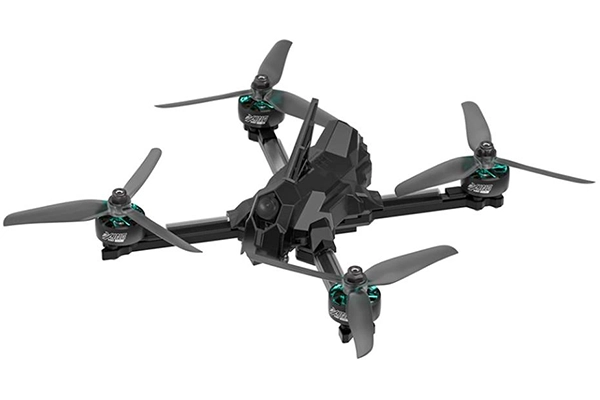
The Mach R5 is iFlight’s entry into the bind-n-fly racing category. It’s got the same compact and agile geometry as most popular racing frames today. What makes the R5 stand out is its aluminum center brace, which adds stiffness and strength. 6mm arms will be difficult to break, but if you manage to do it, they can be quickly swapped. It comes with a 600 mW video transmitter, so you’ll have plenty of range for cruising and freestyle when you’re not racing.
The Sport update of the Mach R5 finally ditches the odd-ball 25mm motors of the original R5. The Sport has the 2207 motors that most other racers are using. 2050 kv is no joke! You might need to turn the RPM down with a motor output limit to get back some control. The Sport also adds a quick-release canopy for easier repairs. But at the cost of durability? One wonders. A plastic injection-molded canopy can’t be as durable as carbon–can it???
Find this product at these vendors:
FIVE33
SWITCHBACK DJI O3
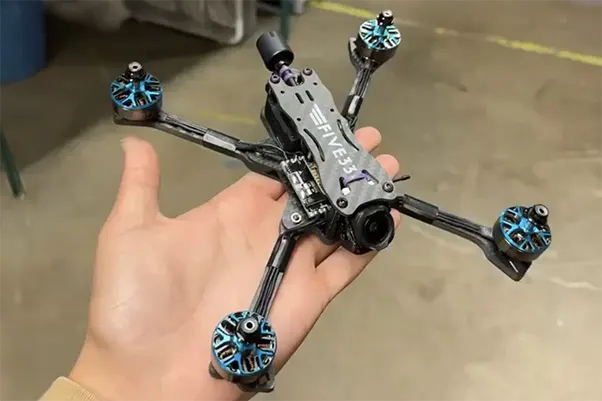
This is a really weird product to recommend. It’s a Switchback RTF with a DJI O3 air unit as the video transmitter and camera. The reason that’s weird is that 1) “big” and “serious” races don’t let you race with a DJI video transmitter, and 2) “serious” racers don’t use DJI because the higher and variable latency makes it harder to fly fast.
So why the heck would anybody buy an RTF racing drone with an O3 in it? Maybe you just want a fun side-quad to rip around the course during practice and get some cool 4k footage with. Maybe you are all-in on the DJI video system and want to experience racing drone speed and agility. Whatever the reason, if Five533 sells this quad, there must be more than a few people out there who want to buy it. Here it is!
Find this product at these vendors:
FIVE33
LIGHTSWITCH V2
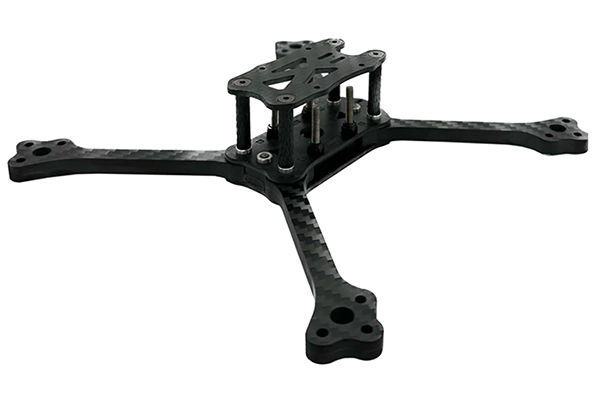
This might be the easiest racing frame to recommend to beginners. It’s well adopted and loved by racers, with 12% of competitive MultiGP racers using it in 2023. That number was higher in 2022, but many of the top-tier racers moved to even lighter frames like the LightSwitch Ultra and the Kronos. But here’s the thing: beginners don’t need to save those 20-ish grams of weight. They’d rather have the increased durability and easier-build of a larger, heavier frame.
Don’t think you’re giving up on performance and capabilities though. The LightSwitch V2 has 6mm T700 carbon arm and vertical carbon stiffeners for the body that provide clean gyro data so you can PID tune the quad within an inch of its life if you want.
Find this product at these vendors:
FIVE33
LIGHTSWITCH V2 ULTRA
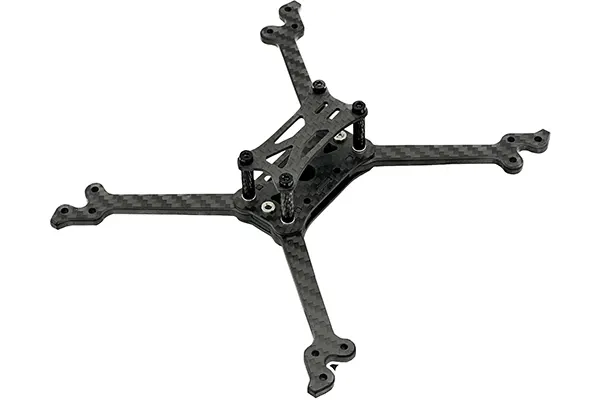
This is a “PRO” version of Lightswitch V2. The main thing it does is use thinner 5mm arms to save weight. It comes in under the “magic” 50-gram number that racers are shooting for today and still fits all 20×20 stacks, even the big ones like Foxeer Slim ESC.
Compared to previous-generation frames like the Switchback Pro, the LightSwitch Ultra saves about 20 grams. Lighter weight in general means faster accelerations and tighter turns. The big question is: are you a good enough pilot to take advantage of it?
The LightSwitch Ultra is used by 15% of competitive MultiGP racers as of 2023.
Find this product at these vendors:
MCK / HYPER
KRONOS
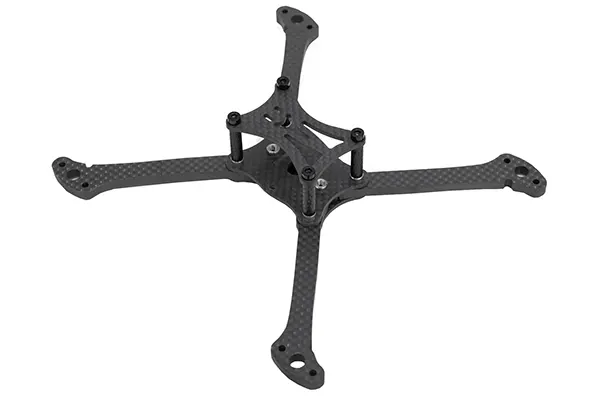
Designed by the fastest two pilots in the world. Absolutely no compromises were made in its design. 18% of MultiGP Nationals pilots were running this frame in 2023, and the majority of them were in the finals.
When we said “no compromises” earlier, we might better have written, “Is a giant pain in the butt to build.” This frame is very tight and even experienced builders may need some creativity to figure out how to fit all their electronics into it. Some combinations of electronics simply won’t work. So if you’re a beginner builder, you should probably skip this frame.
The Kronos makes the unusual decision of mounting the FC and ESC stack 45 degrees. This allows the frame to pull the standoffs in tighter, for more centralized mass. This also reduces how far some of the wider ESC’s stick out past the frame, which improves survivability in a crash. (There is a frame option with standard stack mount if you need the room.)
Regarding stack mounting, the manufacturer states: Due to the small body of the frame, there are some build constraints. The distance between the front and rear standoffs is 37.5mm. This means most ESCs will need to be mounted “sideways” to fit in the straight stack version. On the MCK edition, anything smaller than the Foxeer Slim 60a will fit without modification. Some larger ESCs may require minor modifications to the main battery pads.
Find this product at these vendors:
FIVE33 SWITCHBACK PRO
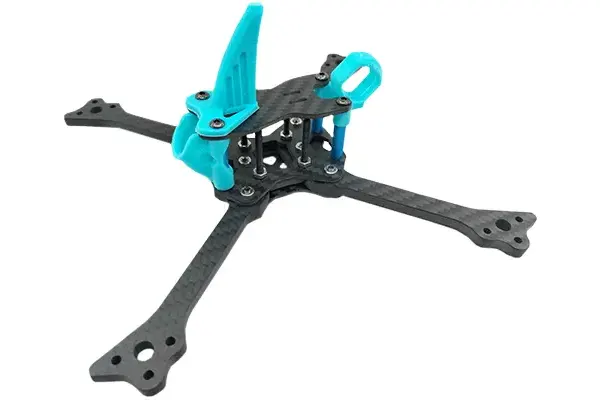
This is the racing frame designed and flown by Evan Turner (HeadsUpFPV), one of the fastest, winning-est pilots in the world. It’s also flown by a lot of his competitors, which says something about how good it is! These world-class pilots could fly any frame they want, including designing one to their exact specifications, and they fly the Switchback Pro instead.
The Switchback Pro has an innovative arm mounting method that gives perfect stiffness while still allowing easy, one-screw arm changes. It’s got a variety of custom-designed 3D prints to suit almost any configuration. It’s tough, lightweight, and proven.
But the Switchback Pro isn’t perfect for everybody. It only supports a limited selection of parts, and fitting everything together in such a tight frame requires some expertise. If this is your first build, you might prefer a roomier frame.
The Switchback Pro is basically the older version of the LightSwitch frame. Although the LightSwitch has basically replaced the Switchback, we’re keeping the Switchback on the list because 1) a lot of people still love it and fly it, and 2) it’s a bit less expensive than the LightSwitch.
Find this product at these vendors:
FIVE33
OPENRACER
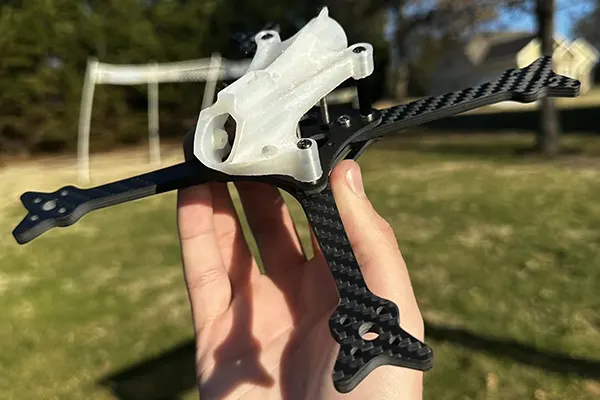
The OpenRacer was designed with a strong focus on durability. Its designer, Limon (yes, the Betaflight developer), does a lot of racing at urban locations like parking lots and car parks, which absolutely decimate racing drones. The OpenRacer is heavier than its competitors – 80-100 grams instead of 50-70 grams. But this weight translates into survivability when you’re smashing into stop signs and curbs.
The OpenRacer is designed to be relatively easy to build. It fits most 30mm and 20mm stacks, although ultra-long ESC’s like the Foxeer Slim are not recommended. It has canopies for analog camera, HDZero, DJI O3, and DJI Vista. It’s even open-source, so you can download files and cut and print your own parts if you want.
Find this product at these vendors:
TBS SOURCE TWO
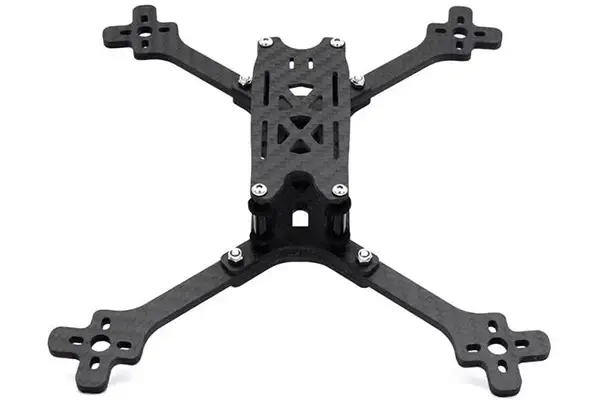
The Source Two is one of the best values in FPV frames. It’s community-designed and all the CAD files are open source and available for anyone to manufacture. As a result, the Source Two is one of the least expensive frames you can get, and available nearly everywhere. (You could even cut it yourself if you have a CNC machine!).
Every time we revise this page, we think about removing the Source Two. The design is heavy compared to modern designs and there are many outdated design choices. But it’s freaking $25 in the USA and $16 if you order it direct from TBS. Like. How can you argue with that. Although this frame isn’t going to impress anybody, there’s nothing really wrong with it, and that’s enough to keep it on the list.
Find this product at these vendors:
The five-inch racing world seems to have mostly settled on 2207 as the ideal motor size. It seems to be the smallest, lightest motor that gives enough torque for excellent handling and enough power for great acceleration and top end speed. The main question left when choosing a motor is the best kv. The kv means the rpms-per-volt that the motor will try to make. A higher kv motor will spin faster and usually make more power, but will be harder on the battery.
Choosing a motor kv is mostly about balancing speed vs. efficiency (flight time). But higher kv motors aren’t necessarily faster for every pilot. Beginners, especially, may find higher kv motors harder to control. For those running 6S batteries, a motor from about 1600 kv to 1750 kv is relatively sedate; a motor from about 1750 kv to 1900 kv is powerful, but still reasonable; and a motor from about 1900 to 2200 kv is probably only recommended for really skilled pilots. (You can effectively scale down a motor’s kv by using the throttle scale parameter in Betaflight’s Rate Profile tab.)
What about the 6S vs 4S argument? In racing, very few people still run 4S. So almost all of the racing motors made come in 6S kv’s only. But I’ve included at least one motor here that comes in around 2400 kv, which is suitable for use with 4S batteries.
FIVE33
2207 1960 KV
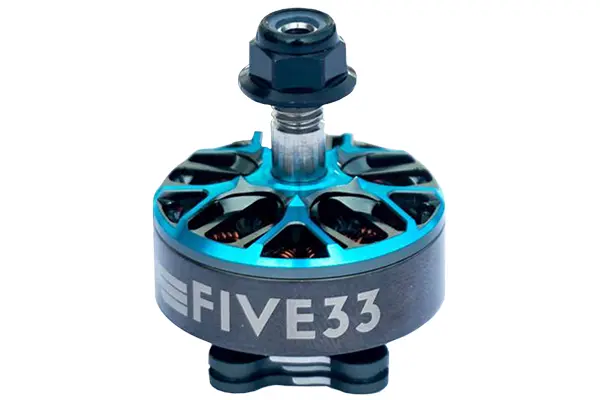
These are the motors designed and used by Evan Turner (HeadsUpFPV), one of the fastest and winning-est pilots in the world. They’re durable, responsive, not too heavy, and not the most expensive either. Frankly, the 533 motors should probably be most people’s “safe” choice just because of their popularity. 20% of pilots at MultiGP Nationsl used them in 2023. An additional bonus is that these motors are approved for use in Freedom Spec spec-class racing.
The links above are to standard motors, with bare wires. Five33 also sells the motors with pre-installed MT30 plugs. This allows for faster, no-solder motor changes in the field. This option adds a tiny bit of weight and isn’t for everybody.
Find this product at these vendors:
FIVE33
2207 CHAMPS EDITION
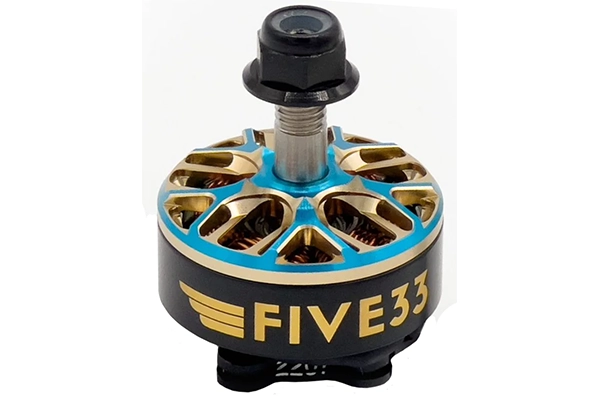
Let’s be honest. Most people would get better lap times if they used a throttle cap to give them more control. Most people aren’t spending a lot of their time at full throttle, and if they do, they crash more often than they finish.
But if you’re one of those crazy fast robots who think the 1960kv version of the 533 motor isn’t fast enough, then the Champs Edition is for you. It’s rated at 2070kv.
We can think of one argument for “normal” people buying this motor. You can always dial down the rpm of a motor using the motor output limit in Betaflight’s PID Profile tab. But you can’t dial it up. Let’s say you wanted a high kv motor for wide open tracks with long straights, but you also wanted a lower kv motor for tight tracks with lots of turns. The Champs Edition could fit both of those bills just by changing a setting in the flight controller.
Find this product at these vendors:
HYPETRAIN VANOVER V2
2207.5 2021 KV
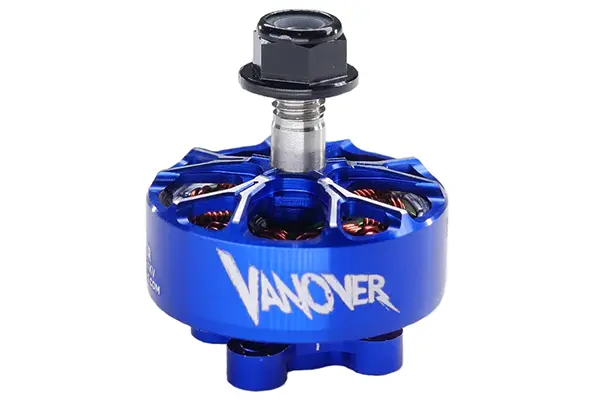
Alex Vanover’s pedigree as a racer includes MultiGP and DRL championships. The HypeTrain Vanover is the result of his collaboration with Rotor Riot to develop his personal racing motor. The Vanover is 2207.5 size, adding 1/2mm to the stator for slightly more torque and power, without adding too much weight (only about 1 gram more than a racing 2207 motor).
After racing on the motor for over a year, Vanover decided to increase the motor’s kv from 1860 to 2021. This, and a few other small changes resulted in the V2 motor. The V2 will give more top end speed and punch, but will be harder on batteries especially if you push the throttle. Beginners may also find the V2 harder to control, since the hover point will be lower in the throttle. (You can always use a throttle scale in the Betaflight Rate Profile section to bring the higher kv motors down if you prefer.) For now, we are linking to both the V1 and the V2 motor since both are excellent depending on the kv that you prefer.
Find this product at these vendors:
RCINPOWER GTS V4 MCK
2207 2100KV
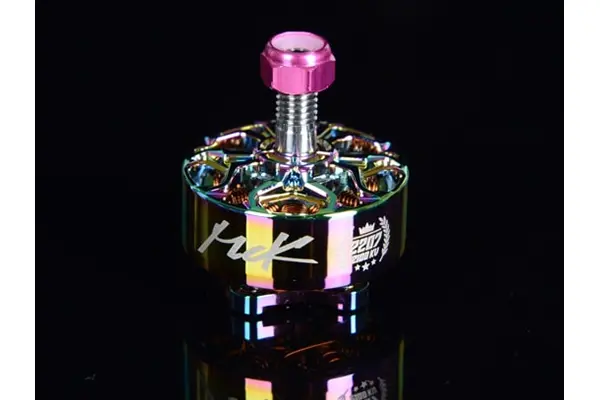
I’m sitting here writing the descriptive text for these motors, and I realized that basically what I did was, find the fastest three pilots around, and then pick their signature motors to include on the list. I guess there are worse ways to go about it. The MinChan Kim is 2207 in size and 2100 kv. In theory, 2100 kv is a 5S motor, but MinChan flies it on 6S because he’s just that ridiculously fast. Regular humans would probably do best to use a throttle scale to bring the power down to manageable levels.
One more thing about this motor: it’s made by RCInPower, which consistently comes out at the top of Chris Rosser’s motor testing for power, torque, and efficiency. Good choice!
Find this product at these vendors:
EMAX ECO II 2207
1700 / 1900 / 2400 KV
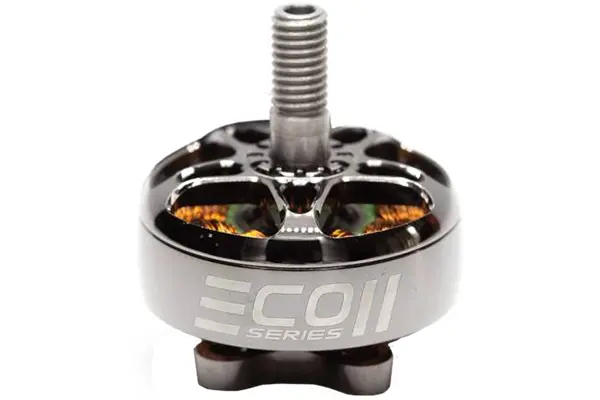
There’s an argument that beginners are better off buying cheap motors. Sure, expensive motors are better, but beginners don’t fly hard enough to really notice. And beginners crash and replace broken motors a lot more often. So they DO benefit from the lower price of cheaper motors.
Introducing the Emax Eco. These are low-mid-tier motors at a budget motor price. They’re not going to give the same power and durability as high-end racing motors, but they’re going to be a lot cheaper to replace when you smash them. At the time of this writing, this motor sells for around $14 to $16, when top-tier motors are going for $24-$27. That’s a big difference!
The main reason you would avoid the Emax Eco would be if you are trying to reproduce your favorite pilot’s exact racing build. If you build a Switchback Pro, like I did, but you put Emax motors on it, then you won’t be able to use Evan’s PID tune, and you won’t know for sure that your quad is flying exactly as good as his. And that might be worth a little bit of a premium to you.
Racing purists are going to be annoyed that the Emax Eco is on this page. This isn’t the motor for them. This is the motor for “normal people” who want a solid motor at a reasonable price. P.S. The 2400 kv version of this motor is for 4S batteries only. Don’t try to run it on 6S. And anyway, why is a racer running 4S?
Find this product at these vendors:
The flight controller (FC) is the brain of the quadcopter. It receives your commands from the receiver and translates that into motor outputs that make the quadcopter fly. The electronic speed controller (ESC) takes the motor signals from the FC and does the actual work of making the motors spin.
For racing, ESC selection is most important. A racing-focused ESC has to be durable because racing drones crash a lot. At high speed. The recommendations on this page have all been vetted by actual pilots flying (and crashing) actual racing drones at the highest level.
Another concern is that the ESC fits inside the frame. Some racing frames are so compact that larger ESC’s literally don’t fit. The frames and ESC’s on this page should all work together.
Racing flight controllers also need to be durable, but they don’t take quite as much abuse as the ESC, so this is a little less of a concern. The simplest thing to do is to pick the same brand of FC as your ESC. This ensures that they can wire together without any annoying re-pinning of the cable that goes between them. Another concern is, if you use a digital video system like HDZero, that the FC has a plug to let the digital video transmitter plug directly into it without soldering.
HOBBYWING &
XROTOR STACK
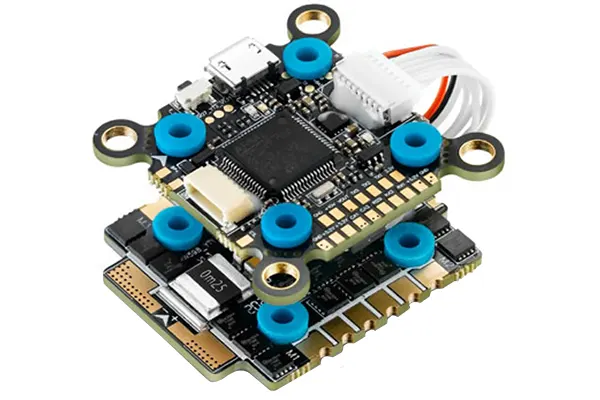
The Hobbywing XRotor Stack has become the standard for open-class FPV racing. Hobbywing has long been known for their excellent ESC’s. The 20mm FC comes with a plug that makes installation of the HDZero video transmitter easy. The FC has a dedicated 12v voltage regulator, which is nice if you’ve got an older video transmitter that doesn’t work from 5v. After the installation of the receiver and digital vTX, the FC will have one spare UART available if you want to add a GPS or some other type of accessory. It also has a vTX kill-switch to power down your analog vTX during team racing or when working on the quad in the pits.
The Hobbywing stack can be purchased with either a 40A or a 45A ESC. The 40A ESC is a lot cheaper, while the 45A is more durable, but a lot pricier. Most racers today run the 40A. Also, don’t let the fact that the Hobbywing is “only” rated for 40A throw you off. Real-world results speak for themselves, and show that this ESC is more than up to the abuse of top-level racing.
Find this product at these vendors:
FOXEER F722 V4 & V4 PRO MINI FC
FOXEER REAPER F4 45A/60A MINI ESC
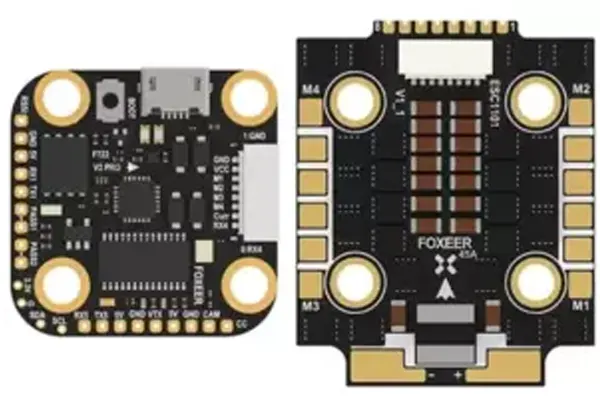
This is the FC if you want something inexpensive that will get the job done. What’s it give up to get the price down? It’s only got four UARTs instead of five; it’s only got a 5v regulator, so your vTX needs to run on 5v if you want the cleanest power to your video transmitter, and it doesn’t have a plug for a digital video transmitter (but you can still direct-solder if you prefer). I have literally talked to racing pilots who reject this FC because they don’t want to solder a vTX to all ten of their racing builds. I don’t judge.
This FC comes in two versions: a standard and pro version. The difference is the pro version has a “real-pit” function that can completely power down the vTX when you’re not using it. The pro version also has more solder pads, but as a tradeoff, it hangs out past the standoffs slightly compared to the standard version.
I recommend pairing this FC with the Foxeer Reaper ESC. The Reaper has been tested and proven by racers since it was released, and it’s extremely durable, especially for its price. The 45 amp version of the Reaper is good, but for modern high-kv 6S builds, the 60A ESC will be more durable.
The 60A Reaper comes in two form factors: square and slim. The Square is shorter front-to-back so it’ll fit between the standoffs of tight frames, but it is wider, so it hangs out a little more over the sides of the frames. The Slim is thinner side-to-side but a little longer front-to-back, which means it won’t fit between the standoffs of some frames, and even if it does fit, there’s an increased chance of damage if you bend a standoff. The square seems to be out of stock a lot of places, so you may need to get the slim if you want this ESC.
Find this product at these vendors:
T-MOTOR MINI F7 HD FC
T-MOTOR 60A 8S ESC
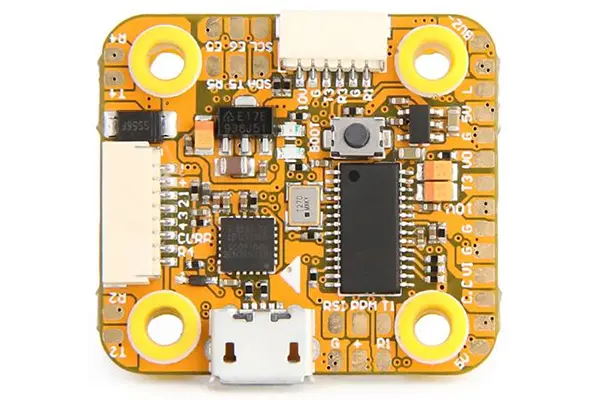
If you look closely at this flight controller, you might guess that it’s actually made by Aikon and sold under T-Motor’s branding. The layout is very similar and the features are nearly identical. No matter who makes it, T-Motor has a great reputation for quality and performance. But mostly, I’m including it as an alternative in case the Aikon is out of stock.
If you go with this FC, the recommended ESC is the F60A 8S. Just like with the FC, we suspect this is actually designed and/or manufactured by Aikon, and that’s a good thing. This is as close to bulletproof as a racing ESC can get.
Find this product at these vendors:
AIKON F7 FC & AIKON PRO ESC
(DJI READY) / 20MM FC & ESC
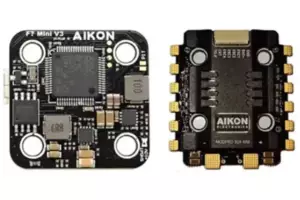
Aikon has made some of the strongest, most durable ESC’s on the market for years. It’s no surprise that their 20mm Aikon Pro ESC is one of the few that can stand up to the abuse of FPV racing. The Aikon flight controller has an F7 processor with plenty of UARTs for peripherals. It’s got a built-in 10v regulator to power DJI (if you choose to race on DJI, this is your pick) or your analog vTX. It’s even got a built-in pit switch to let you power down your vTX with an aux switch. The main downside of this FC is that the solder pads are very small, but that’s sort of true for all 20mm FC so maybe it doesn’t matter.
Find this product at these vendors:
REDUX32 F4 NANO
50A V2 20X20 ESC
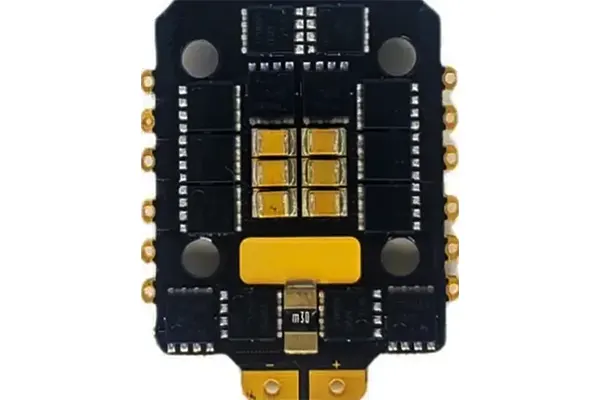
Unlike the other entries, this one is going to start with the ESC, not the FC. Redux Air makes what might be the toughest, highest-performance 20mm ESC available today. It uses the same larger, higher-rated FETs used on 30mm ESC’s. And somehow, they managed to shrink it down from its predecessor so it’s about the same size as other 20mm ESC! In my opinion, this is one of the best 20mm ESC’s you can buy today. If you can find it in stock.
This ESC can be paired with almost any FC, but you will probably have to re-arrange the order of the wires in the harness connecting them together.
Find this product at these vendors:
Every FPV aircraft has a camera and a video transmitter to send the camera feedback to the pilot. Which camera and video transmitter you choose depends on which video system you’re using. Video systems are divided into two categories–digital and analog–and we have a page with recommendations for both.
If you’re using a digital video system (DJI, Walksnail, or HDZero), CLICK HERE.
If you’re using an analog video system for racing, CLICK HERE.
And if you’re still not sure which is best for you, here’s a video to help you decide:
The batteries selected for 5” racing are all 6S. Can you race on 4S? Sure. You can do whatever you want. But 6S is where basically all racing motors are focused today, and 6S is what most racing pilots run. Any of the 4S packs in the 5” freestyle section could work for racing if you need to go that direction.
The main difference between the packs chosen here and the Freestyle packs is that these packs are slightly larger in size. Racers hit their packs hard. A larger pack can deliver more current at the cost of slightly greater weight. Since racing rigs are already pretty light, you can probably afford a few more grams of battery if it means you get to finish your race, or you experience less sag when you punch the throttle.
CNHL BLACK
1300 MAH 6S
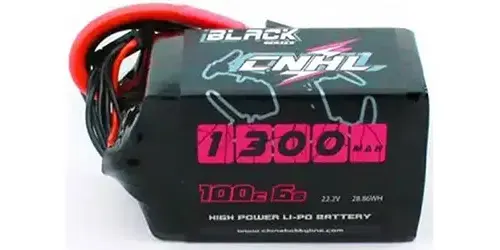
Find this product at these vendors:
GEMFAN HURRICANE
51466
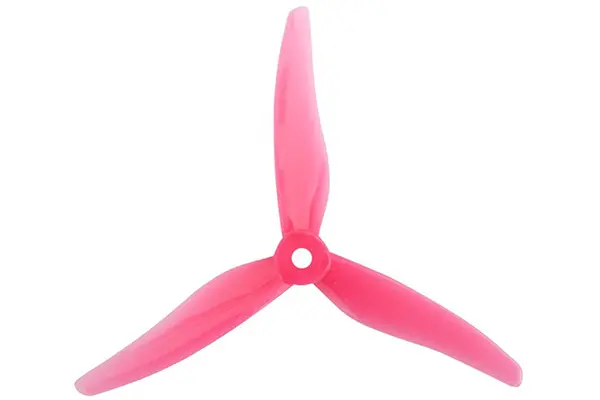
Find this product at these vendors:


